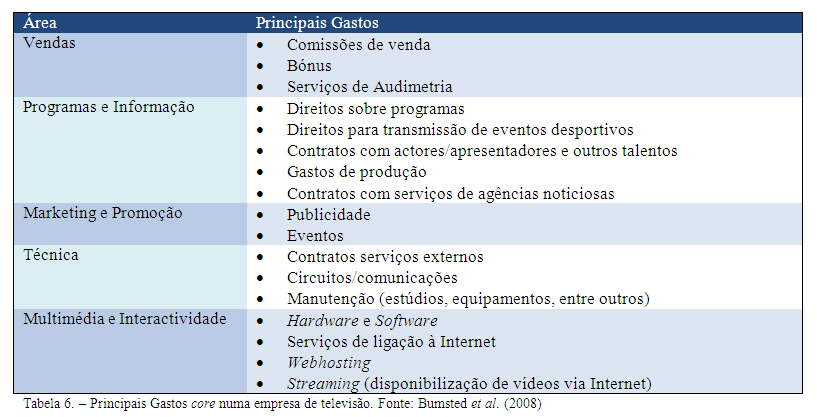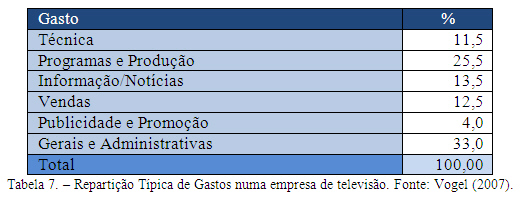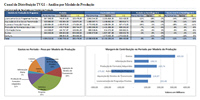 | ||||||||||||||||||||||||||||
| ||||||||||||||||||||||||||||
|
|
3.2 - Business Model In essence, the traditional business of television is based on delivering audiences to advertisers, or reach a wider audience through the programs to sell to companies wishing to advertise their products and services. Currently, we can distinguish three main types of TV companies:
3.2.1 - Customers In the traditional business model of commercial television, the sale of advertising space is the main source of income. Many television channels whose business model is based on pay-tv, or in amounts paid by policyholders, also sell advertising space that are not their main source of income, is often an important factor. Subscription channels in the U.S., the average weight of advertising revenue is between 5% and 10% of the total (Bumsted et al., 2008). According to Pringle and Starr (2006), a commercial television station serves two types of customers:
The greater the success of management programs to reach a wider audience, the higher the income raised by business management. Successful programs attract audiences, which in turn attract advertisers and generate revenues. The higher yields, better programs that can transmit. The programming and sales are thus part of a cycle that has a major impact on the financial health of the company. 3.2.2 - Product: time The advertising space is sold in seconds. Traditionally spots are sold thirty seconds, although other durations are also common. In Portugal, in 2009, the average length of advertisements on national channels open signal was 25 seconds. In December 2009, each of the four signal channels open delivered a daily average 3h46m advertising, a total of 467 hours (Marktest, 2010th). The transmission time is a perishable commodity, and can not be stored after "expired" can not be sold. This is a feature similar to other industries such as air transport. After a trip to vacant posts can no longer be traded. The time available for advertising block can not be too long, otherwise saturate and lose the audience. In addition, there are legal restrictions in many countries the maximum number of minutes per hour devoted to advertising. In Portugal, the legislation limited to 12 minutes per hour of advertising on commercial channels and 6 minutes on the first channel of public television RTP - Radio e Televisão de Portugal, SA (Article 40 of Law No. 27/2007 of 30 July; Contract Public Television Service, Section 23, paragraph 1). For many companies from U.S. television, the daytime programming is more profitable. Despite the smaller audience, the advertising breaks are longer and spending programs is relatively low (Vogel, 2007). The earning potential of a program should be taken into account in assessing the investment involved in the program and placed at a certain time. To evaluate the potential income shall be considered the following factors: the number of spots available in 30-second program, the average selling price of each spot in the time period under evaluation - which depend on the potential audience, the level of sales, ie, the percentage of spots potentially sold, sales commissions - if any. Taking as an example a program with six minutes available for advertising and an average selling price of € 400.00 per each thirty-second spot, the calculation would be as follows (Pringle and Starr, 2006):
3.2.3 - The Hearings The success of a television station, to attract viewers, or viewers, is measured in ratings points (rating). This clearance is done by specialized companies, like Nielsen or the U.S. Marktest in Portugal. By placing a device that records what is being viewed on television receiving equipment, known as audience measurement, a certain number of households and selected according to the characteristics considered relevant to the population, particularly age, gender, geographic location and social class, the audience is inferred for the total population. The results are recorded in a segmented manner taking into account these variables. The main measures used by audience measurement are as follows:
3.2.4 - Models of Advertising Sales Advertising can be sold in several formats. The following forms are the most common and heavier in the invoicing of Portuguese television companies:
While the first two forms are entirely independent of the programs and their contents, since the micro-spaces or product-placement must be fully integrated into the program, encircled in their production. The sale of advertising is affected by seasonality. In Portugal, the months of higher sales are April, May, October and November. As for the weaker sales recorded in January, February and during the summer The sale of time for breaks for commercials can be done in two ways:
The responsibility for distribution of the various spots that make up an advertising block is the television station, however, fees can be paid by the advertisers location to ensure the best positions in the block, the initial and final respectively. The TV company has always taken care not to give competitors two spots together, for example, two advertisements of telecom operators. In this context there is yet another concept, the GRP - Gross Rating Points - indicates that the sum of the audience for all spots in a campaign, for example, if a spot was aired three times a week, gaining 5% respectively, 7 % and 8% audience will total 20 GRP's. Those responsible for defining the GRP's campaign to achieve and manage the placement of spots according to this objective. CPP - Cost per rating point - derived by dividing the investment in a campaign for its GRP's. This indicator allows to compare and evaluate the effectiveness of a campaign (Vogel, 2007). According to data provided by Marktest (2009a) in 2008 were the following companies with greater investment in television advertising in Portugal: 
In the USA, according to Nielsen (2010th), the business sectors with higher investment in advertising (TV, radio, print) in 2009 were as follows: 
3.2.5 - Other income The structure of income from television companies have been changing. Although the majority come from the sale of advertising, new sources of income have emerged and increased their weight. We present here a few:
3.2.6 - Expenses Most of the expenses of a television company is associated with areas of programs and information. In addition to overhead and administrative expenses are common to all areas such as salaries, facilities, communications, software and others, which are similar to any other area of business activity will not be detailed. The main expenses related to the core areas of a television company are as follows (Bumsted et al., 2008): 
In a television company operating expenses are relatively fixed, so the key to increased profitability is the revenue growth. If the demand for advertising increases, the price of spot increase, but spending will remain, since the program's cost to expenses associated with transmission. This applies a logic of short-term. This does not mean that operating expenses should be disregarded because the profitability of long-term evolution will also depend on the costs associated with administrative and support areas (Vogel, 2007). According to Vogel (2007), the apportionment of the expenses of a typical television station will be as follows: 
Investing in different kinds of programs also varies. Taking for example the three largest U.S. television, the investment in news / information is approximately $ 500 million per year. Daytime soap operas to be produced for about USD $ 150,000 per half hour or $ 200,000 for one hour, competitions and talk shows require a much smaller investment, in prime-time shows the investment amounts to USD 1.5 million per hour, the production of reality shows is also relatively inexpensive to produce (Vogel, 2007). With regard to control spending, the conduct of detailed budgets and analysis of their performance throughout the year will be a key step towards the identification of deviations and the corrective measures. The centralization of operations, minimizing investment and operating expenses could also contribute to a reduction in expenditure (Bumsted et al., 2008). |
|
||||||||||||||||||||||||||
nunofonseca.com - All rights reserved.


